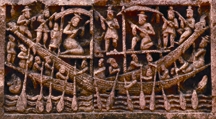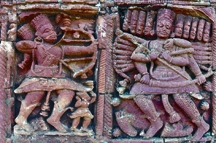Kantanagar Temple
Kantanagar Temple an eighteenth century brick temple, situated in the peaceful island hamlet of Kantanagar (Kantanagar), about 12 miles north of Dinajpur town, and about a mile west of Dinajpur-Tetulia highway across the Dhepa river. It has gained eminence as an outstanding monument in Bengal for its fabulous terracotta embellishment. This nava-ratna or 'nine spired' Hindu temple, now stripped off its original nine spires atop its corners during the devastating earthquake of 1897, exhibits the exuberance of terracotta art at its best in Bangladesh.

The confusion about the date of its construction can be settled from the record of a chronogram in the Sanskrit stone inscription, fixed on the northeast corner plinth of the temple. It records that Maharaja Prannath of Dinajpur began its construction about 1722.
His adopted son Maharaja Ramnath completed it, in Shaka era 1674 (1752 AD) in order to propitiate the consort of Rukmini in fulfillment of his father’s wish. However, in the early 20th century Maharaja Girijanath Bahadur restored it substantially, except for the missing nine spires.
This magnificent pyramidal temple rose in three receding terraces and was crowned with nine ornamental spires or ratnas (jewels) on the corner of the three terraces which imparted to it an appearance of a huge ratha or an ornate chariot resting on a high plinth. It was provided with arched openings on all four sides in order to enable devotees to see the deity enshrined inside from all directions.

The 15.84 sq km temple stands in the centre of an oblong court (73.15m ' 36.57m) enclosed by a pilgrim shed with a corrugated tin roof. Its main fabric pivots around a nuclear square cell (3.04m), shooting up to a height of about 15.24m above its 1.005 m high plinth of stone, believed to have been quarried from the ancient ruins of Bannagar near Gangarampur in Dinajpur. Three other square outer shells in graded heights have been added to it, as much to variegate the plan as to strengthen the central cella which carry atop a massive tower. The other eight ornamental towers, now missing, occupied the eight roof corners of the lower two stories.
The curved cornice of the ground floor, sharply drooping at the corners, rise in the middle to a height of 7.62 m from the plinth, while that of the first floor rises to 4.56m and that of the second floor to 1.83 m. There are small square cells at each of the four corners of the ground and first floors for supporting the heavy load of the ornate octagonal corner towers above.

The temple accommodates four rectangular corridors on the ground floor around the prayer chamber measuring 9.17 m × 1.53 m and 4.57 m×1.22 m. On the ground floor, there are three multi- cusped arched entrances on each side, each separated by two richly decorated brick pillars. The number of arched doorways in the ground floor disposed in its four shells is 21; that of the first floor is 27. The reduced second floor has only three entrance doors and three windows. A narrow strip of staircase, merely 0.70m wide, built into the western second corridor, winds up through its dark passage to the first, second, and third stories.
A small derelict single spired temple, now overgrown with rank vegetation, stands about one hundred yards north of the main temple beyond the pilgrim shed, which is believed to have been erected by Maharaja Prannath in 1704 where he initially installed the Krisna icon, brought from Brindaban. The icon was later transferred to the 'nava ratna' temple when completed. It is now an abandoned shrine. It is a 16-sided temple rising to a height of about 12.19 m and provided with a multi-cusped arched entrance on the south.
Terracotta Decoration Every available inch of its wall surface from the base to the crest of its three stories, both inside and out, pulsates with an amazing profusion of figured and floral art in unbroken succession.
The vast array of subject matter include the stories of the mahabharata (Mahabharata) and the ramayana (Ramayana), the exploits of Krisna, and a series of extremely fascinating contemporary social scenes depicting the favourite pastimes of the landed aristocracy.

The astonishing profusion, delicacy of modeling, and the beauty of its carefully integrated friezes has seldom been surpassed by any mural art of its kind in Bengal. However, even in its bewildering abundance of diverse motifs, one can observe a carefully arranged thematic scheme in the composition of subject matters at different levels and spaces on the temple wall.
In general pattern of terracotta decoration of the temple's outer walls, the lowest four basal panels, running parallel across the four faces, depict from bottom upward, immediately above the plinth: (a) a recurring floral motif, consisting of full blown rosettes alternated with a four-foiled foliate pattern; (b) the second frieze portrays contemporary social scenes and the hunting parties of the landed nobility; (c) the third parallel panel above depicts an intricately designed series of full blown rosettes commonly found on earlier Sultanate mosques such as at the shatgumbad mosque, bagha mosque, kusumba mosque, chhota sona mosque etc.

The second register depicts animated hunting scenes of wild games, royal processions of elephants, horses, camels, and dainty ox-carts of the nobility with their retainers in Mughal dress and arms.
The richly caparisoned majestic elephants and splendid stallions, their chariot and harness are vividly delineated; corpulent zamindars are seen squatting in their gilded palanquins puffing from luxurious hukkas with long sinuous pipes. Still other panels portray river cruises on long slim boats crowded with revellers; squads of soldiers often wearing European dress are also shown marching with drawn swords and even muskets.
Mythological scenes on the third register depict the nativity of Krsna (krishna); the demon King Kangsa; successive attempts to kill the infant Krsna; Krsna's killing of the Putana ogress and the Bakasura or crane-demon; the lifting of Govardhana mountain, the killing of Keshi; the quelling of the snake-demon, Kaliya, and Krsna's pleasure ride on a long slim boat with revellers. The south face of the temple also presents stories from the Ramayana in a somewhat confused sequence. Ramayana stories continue on the east face. Here the exile of Ramachandra, Sita, and Laksmana in the Panchavati forest; Laksmana's striking off the nose of Shurpanakha; the abduction of Sita by Ravana from Dandakaranya; Jatayu's futile attempt to obstruct the chariot of Ravana; the captivity of Sita in Ashoka Forest; the fight between Bali and Sugriva with their monkey followers for the throne of Kiskindhya; Ramachandra's sapta tala veda and Sugriva with his monkey followers and their palaver with Ramachandra are shown in striking details.

The north face predominantly portrays scenes of Krsna and Balarama. Thus Krsna's various marriages and cowgirls carrying milk and curd pots in shika (string bags) suspended from pole etc are shown. In the second register an interesting European battle ship is depicted in great details with soldiers and a cannon.
The entire western face of the third register depicts various episodes from the Krsna legend, ending in the slaying of Kangsa, the demon king of Mathura. It includes the annihilation of Kuvalayapida, the monstrous killer elephant of Kangsa; and Radha's fainting fits on her failing to dissuade Krsna from participating in Kangsa's sport tournament in Mathura. Of particular interest is a group of cowherds carrying milk and butter in string bags, suspended from a pole on shoulder, which is still a familiar scene in rural Bengal.
The elaborate panels over the spandrels of multi-cusped arches exhibit animated battle scenes from the great epics and also rasa-mandala, with dancing Radha-Krsna couple within circles, and a host of accessory figures. The spirited battle scenes of Kuruksetra and Lanka are depicted with great vitality and invention by the folk artists.

In the seemingly inexhaustible store of terracotta mural decoration on the temple wall, the folk artists, mostly from Krsnanagar, often have left behind the imprint of their keen awareness of the environment in which they lived. The deities they depicted in panels were sometimes treated with an astonishing sense of reality and as intimate and familiar members of their society. For instance, an extremely interesting series of upright western panels on the bottom register of the western face depicts Krsna plucking coconut from the tree and handing them over to one of his companions climbing halfway up the trunk, who, in turn is delivering these to another companion waiting on the ground. It is a familiar scene in Bengal where the deity is intimately shown as one of the members of society. Individual plaques often display idiosyncratic compositions such as the one found at the inner face of the corridor on the south face where Radha-Krsna are shown dancing on an elephant very cleverly composed of a dozen human figures. Again, on the northern face, Krsna is depicted with one of his newly wedded bride seated on a pidi (low wooden stool) under a canopy where she is coyly holding her veil with one hand over her head and bashfully peeping at her lord. This, of course, is an endearing familiar wedding scene in rural Bengal. In the bewildering crowd of friezes, one may even find Krsna squatting nonchalantly with folded knees, tied with a gamchha (a strip of cloth) round the knees and back, in a posture altogether uncommon among Bengalees, but common among the working classes in adjacent Bihar.
However, one distinctly delightful aspect of the fabulous terracotta ornamentation of the Kantanagar Temple (Kantaji Mandir) is its restraint in depicting erotic scenes. In this, it is unlike Orissan and South Indian temples.
The endless panels of terracotta art embellishing the wall surface of the Kantaji Mandir, have a life and vitality of their own and are deeply imbued with the spirit nourished for thousand years on the silt-laden soil of Bangladesh. In a country like Bangladesh, being formed by enormous volumes of fertilizing soft alluvium, the development of an indigenous terracotta art was a logical outcome, given the absence of stone. The tradition of this plastic art is rooted in the early historic period, especially during the Pala-Chandra period, when Buddhist temples at paharpur (Pahadpur), mainamati, bhasu vihara, Sitakot and other monuments were enlivened with floral and figured terracotta art. These plaques are however, large and usually archaic, but the terracotta embellishments on the Kantanagar temple walls are of totally different nature. They represent a highly sophisticated mature art with a very carefully integrated scheme of decoration. Contrary to the earlier tradition of isolated and somewhat unrelated composition, the art in this temple was composed of several individual plaques, integrated into an extended composition so that the entire space followed a rhythm. The effect often is more like a richly decorated carpet or embroidered tapestry than an architectural composition. [Nazimuddin Ahmed]
